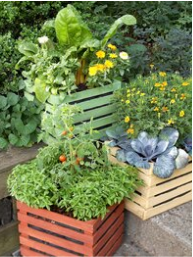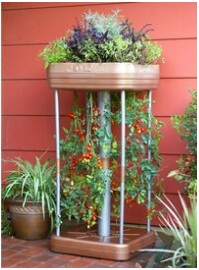Create a Gorgeous Edible Garden
You can grow quite a bit of food in just a few pots. These herbs and veggie container garden ideas will also make stylish additions to your doorstep, deck, patio, or garden.

Add Color with Containers
Boost the color in your garden by using bright pots. These glazed containers in cheery shades of blue, orange, and yellow instantly add interest to a display of purple basil, Hungarian Wax pepper, tomato, parsley, and golden oregano.

Grow Up
Plant your vegetables in hanging baskets if ground space is scarce. Compact or “bush” varieties are best, though many herbs are also perfect picks for baskets. This pairing of tomato and basil, for example, creates a delicious and attractive display.
Test Garden Tip: Set up a drip-watering system to save you a substantial amount of time with a hose or watering can.

Be Creative
Give your plantings personality and save money by using recycled containers. Here, old wine crates provide a perfect home for small varieties, including lettuce, Thumbelina carrots, everbearing strawberries, and signet marigolds.

Stagger Height
Select containers of different sizes and create a grouping to offer additional interest. These four containers filled with cucumber, tomato, pepper, basil, thyme, and parsley add lots of visual appeal to a landscape.

Incorporate Colorful Varieties
Use vegetables with attractive foliage, flowers, or fruits in your favorite planters. Here, red-stemmed Swiss chard, glowing Lemon Gem marigolds, and a hot pepper add great color and texture to a container.

Grow Edible Flowers
Add color and cheer to your containers (plus your salads, desserts, and other dishes) by growing edible flowers. Note how calendula and signet marigolds brighten a planting of Swiss chard, cabbage, basil, and tomatoes.

Make an Herbal Window Box
Let great scents waft in your home each time you open a window by growing herbs in your window boxes. This lovely example incorporates variegated sage, variegated thyme, Italian parsley, and sweet alyssum.

Use Textural Contrasts
Make a stunning statement even if you’re growing all-green plants by combining textures. Here, rosemary’s fine, needle-like leaves are a perfect balance to the big, bold eggplant. A potted citrus, lemon verbena, and thyme further enhance the effect.

More on Texture
Grasses seem to go with everything because their fine textures show off other plants well. Get the look in your vegetable garden by incorporating onions and chives. They work well with the cucumbers, tomatoes, and peppers shown here. And happily, their flavors are a perfect fit, too!
Lemongrass is another great pick for adding a grassy texture.

Enjoy Climbers
A scrambling cucumber is the star of this container creation. With its big leaves, bright flowers, and yummy fruits, it’s a natural showstopper, especially when paired with an upright plant such as rosemary.
Test Garden Tip: Make harvest easy by letting cucumbers grow along the railing of your deck or patio.

Provide Support
You can also give vines such as cucumber, beans, or peas an upright support such as this obelisk. By letting vines grow up, there’s space in the container to grow trailing plants such as nasturtium and fillers such as kale, signet marigolds, and eggplant.

Try Succession Planting
Gardeners get more produce from a small space by using a technique called succession planting. Once your plants are finished producing fruits or veggies for the summer, replace them with something else (such as a cool-season vegetable like broccoli if the warm weather is coming to an end). For example, the lettuce in this container will fade in summer, allowing you to grow eggplant, pepper, or another heat-loving variety with lovely lemon verbena.

Keep it Manageable
You may be able to get more plants than you think in a tight space. Here, just four pots provide a plethora of produce: Cucumbers, rosemary, Swiss chard, tomatoes, kale, eggplants, basil, peppers, and more. Limit the number of varieties you grow to only what you can use to save time
and effort.

Make Them Handy
Place your containers where you’ll be able to access them easily. It might be right outside your kitchen door, next to the grill to enhance a summer meal, or beside your favorite bench or chair for convenient harvesting.

Play off Plants
Not sure what to plant together? Look for hints in leaf, flower, or foliage color. Note how the purple tones of blue basil play perfectly with the deep, dark leaves of Black Pearl pepper. Purple Ruffles basil, red cabbage, or Kolibri kohlrabi would also mix wonderfully.

Match Your Style
Create a lush look by growing plants that seem to explode with color, texture, and fragrance. See how nasturtiums, signet marigolds, peppers, tomatoes, basil, and pineapple sage fill this area with cottage garden elegance.

Accessorize Your Container
Leave a little space in your containers for garden decor. Here, a bentwood trellis adds color and interest to a planting of basil, parsley, and chives.

Add a Touch of Art
If you want your container of herbs or vegetables to be more of a focal point, try tucking in an eye-catching piece of garden art. For example, this little container gets the perfect accent from a collection of bee skeps.

Go Upside Down
Down is the new up! Why not try growing your tomatoes underneath their pot? Whether you choose hanging baskets, a five-gallon bucket with a hole on the bottom, or something else, it can be an interesting way to cultivate your favorite vegetable.

